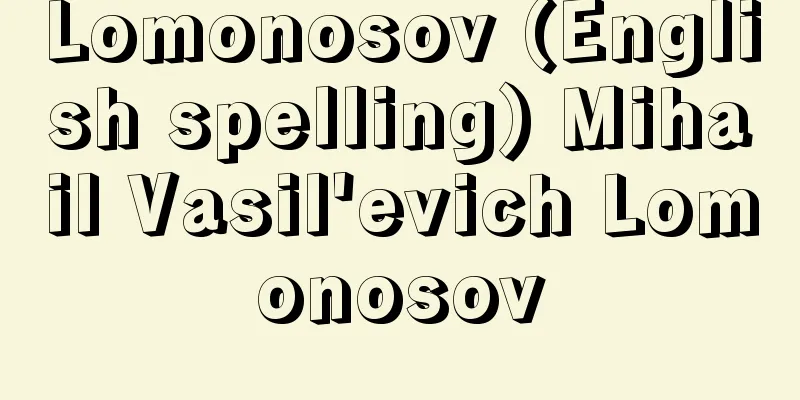Lomonosov (English spelling) Mihail Vasil'evich Lomonosov

|
A Russian natural scientist, poet, and humanist. He was born in Arkhangelsk Governorate, which faces the White Sea. His father was a free peasant, which was a privilege for the time, and his family business was farming and selling fish. He went to Moscow and entered the Slavic Greek Latin Institute (1731), and in 1735 was sent to the university attached to the St. Petersburg Academy of Sciences (now St. Petersburg University), and the following year, in 1736, he was sent to Germany to study metallurgy and mining. He studied at the Universities of Marburg and Freiberg, and traveled around Germany and the Netherlands. In 1741, he returned to Russia, and the following year, in 1742, he became an assistant in physics at the Academy of Sciences. In 1743, he was placed under house arrest for eight months due to a conflict with the German bureaucrats who controlled the Academy, but in 1745 he was appointed a full member of the Academy and a professor of chemistry, and in 1748 he established Russia's first chemical research laboratory. In 1757, he became an advisor to the Academy's secretariat, and worked hard to realize an Academy of Sciences run by Russian scholars. He was appointed director of the Academy's geographical department in 1758. He also played a leading role in the founding of Moscow University (1755). He was an honorary member of the Swedish Academy of Sciences (1760) and a member of the Bologna Academy of Sciences (1764). [Masanori Kaji] Scientific achievementsLomonosov emphasized the importance of theoretical research in science, not just the accumulation of data, as well as experimental research. His theoretical bases were the particle theory of the structure of matter, the kinetic theory of heat, and the laws of conservation of matter and motion. He opposed the idea of immeasurable fluids, which was popular at the time. He accepted phlogiston to explain combustion, but assumed that it was weighable and material. He considered a particle-like and hierarchical structure of matter, similar to the concept of atoms and molecules. He carried out experimental research based on the above theoretical standpoint. For example, in 1756, he conducted an experiment on heating metals in a sealed glass tube, refuting Boyle's explanation that the increase in weight of metal incineration was due to the absorption of fire particles. However, theoretical experiments were not understood within the Academy of Sciences at the time, so he focused on chemical and technical experiments, for example, he conducted research on glass manufacturing and revived the technique of mosaic painting (his mosaic design ``The Battle of Poltava'' (1762-1764) still exists). His other scientific achievements include research into atmospheric electricity, metallurgy and mining with the aim of developing Russia's resources, proposing the development of Arctic sea routes and inventing astronomical and navigational instruments, studying icebergs, and directing the production and publication of Russian maps. Despite such a wide range of pioneering scientific achievements, after his death, his role as a natural scientist was forgotten, along with the many unpublished drafts of his theses, and he was only regarded in Russia as a poet and humanist. It was only through the research of Russian science historians in the early 20th century that he finally received due recognition. [Masanori Kaji] Literary achievementsIn the field of humanities, Peter played such an important role that he was called "the Peter the Great of Russian literature." He wrote "Russian Grammar" (1755), developed the theory of poetry, and formulated a three-part theory of style by organizing the relationship between Church Slavonic and Russian according to the genre of literary works. He also wrote works such as odes, lyric poems, allegorical poems, and the tragedy "Tamira and Selim" (1750), including "Morning Meditations on the Greatness of God" (1751). He also refuted the Norman theory of the origin of Russia, which was put forward by a German historian. [Nakamura Yoshikazu] [References] | | |Source: Shogakukan Encyclopedia Nipponica About Encyclopedia Nipponica Information | Legend |
|
ロシアの自然科学者、詩人、人文学者。白海に面したアルハンゲリスク県出身。父は、当時としては恵まれた自由農民に属し、農耕と漁獲物販売を家業としていた。モスクワに出て、スラブ・ギリシア・ラテン学院に入学(1731)、1735年ペテルブルグ科学アカデミー付属の大学(現、ペテルブルグ大学)に送られ、翌1736年冶金(やきん)学、鉱山業を学ぶためにドイツへ派遣された。マールブルク大学、フライベルク大学に学び、ドイツ、オランダの各地を旅行して、1741年帰国、翌1742年科学アカデミーの物理学助手。1743年にはアカデミーを支配するドイツ人官僚との対立から8か月の自宅監禁にあったが、1745年アカデミー正会員、化学教授に任命され、1748年ロシア最初の化学研究実験室を設立した。1757年アカデミー事務局顧問となりロシア人学者による科学アカデミーの実現に努力した。翌1758年にはアカデミーの地理局局長にもなっている。またモスクワ大学の創立(1755)に指導的な役割を果たした。スウェーデン科学アカデミー名誉会員(1760)、ボローニャ科学アカデミー会員(1764)でもあった。 [梶 雅範] 科学上の業績ロモノーソフは、データの単なる集積でない科学における理論的研究の重要性を、実験的研究とともに強調した。物質構造についての粒子理論、熱の運動説、物質と運動の保存則の三つが彼の理論的な立脚点であり、当時流行していた不可秤量(ひょうりょう)流体の考え方に反対した。燃焼を説明するフロギストンは認めたが、可秤量で物質的なフロギストンを想定した。原子と分子の概念に近い粒子的で階層的な物質構造を考えた。以上の理論的立場にたった実験的な研究を行い、たとえば1756年には、密封ガラス管中の金属の加熱実験を行って、金属灰化の重量増加を火の粒子の吸収によるとしたボイルの説明に反駁(はんばく)を加えた。しかし、理論的実験は当時の科学アカデミー内で理解が得られず、化学技術学的な実験を主とし、たとえばガラス製造の研究を行って、モザイク画の技法を復活させた(彼の設計したモザイク画『ポルタワの戦い』(1762~1764)は現存)。ほかに空中電気の研究、ロシアの資源開発を目ざした冶金・鉱山学の研究、北極海航路開発の提案と天文観測用・航海用器械の発明、氷山の研究、ロシア地図の製作・発行の指導などがある。このような広範囲にわたる多くの先駆的な科学上の業績があるにもかかわらず、彼の死後、未発表の多くの論文草稿とともに自然科学者の面は忘れられ、ロシア国内でも詩人、人文学者としてしか評価されなかった。20世紀初頭のロシアの科学史家の研究によってようやく正当な評価を受けるようになった。 [梶 雅範] 文学上の業績人文科学の分野では「ロシア文学のピョートル大帝」と称されるほどの役割を演じた。『ロシア文法』(1755)を著し、作詩理論を発展させ、教会スラブ語とロシア語の関係を文学作品のジャンル別に整理して3文体論を定式化したばかりでなく、『神の偉大さについての朝の瞑想(めいそう)』(1751)をはじめとする頌詩(しょうし)、叙情詩、寓話(ぐうわ)詩、悲劇『タミラとセリム』(1750)などの作品を書いた。ロシアの起源をめぐってドイツ系の歴史学者の唱えたノルマン説に反駁(はんばく)したこともある。 [中村喜和] [参照項目] | | |出典 小学館 日本大百科全書(ニッポニカ)日本大百科全書(ニッポニカ)について 情報 | 凡例 |
<<: Loch Lomond (English spelling)
>>: Street car - romendensha (English spelling)
Recommend
Emperor Gohanazono
Year of death: Bunmei 2.12.27 (1471.1.18) Year of ...
Surface hardening - Hyomen yakiire (English spelling) surface hardening
This is a method of hardening only the surface lay...
Cheyletus eruditus
...The palps are well developed and powerful, wit...
The Kusunoki clan
A local lord who was active from the end of the K...
gallery test
… The degree to which explosives are unlikely to ...
Kyoto Blind and Blind Institution
This is the nickname of Japan's first school f...
Yuasa Hangetsu
Born: February 16, 1858 (5th year of the Ansei Era...
Jade Emperor - Gyokko
The Jade Emperor (Shang) is the supreme deity of T...
Claim objection lawsuit
A suit aimed at eliminating the enforceability of...
Tourismus
…The word tourism began to be used in the UK at t...
Space velocity
The minimum speed that a rocket or other flying ob...
Magnat
...The Senate, which, together with the Chamber o...
Patas monkey - Patas Monkey (English spelling)
An Old World monkey (illustration) belonging to th...
Tasman - Abel Janszoon Tasman
Dutch navigator and explorer. He served as a capt...
Typography
A technique for combining type for printing. In Eu...









